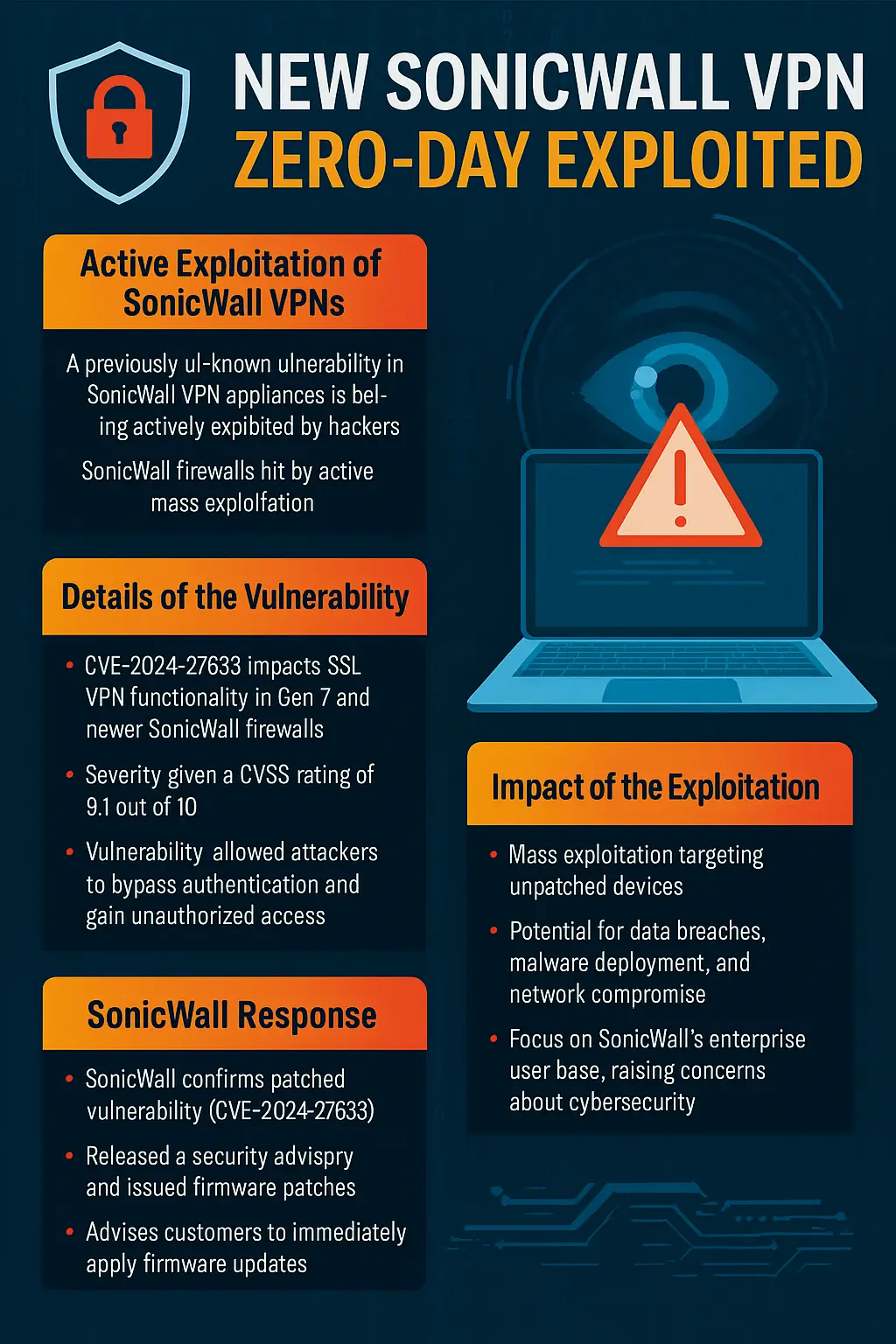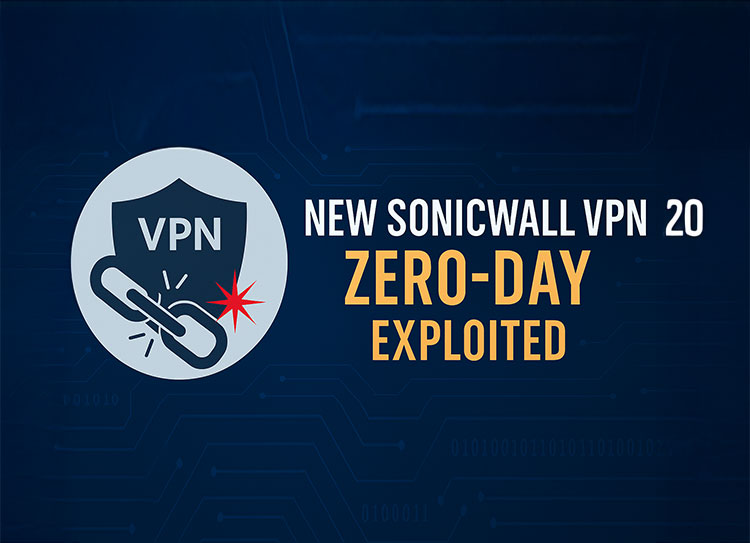New SonicWall VPN Zero-Day Exploited: A Deep Dive Story by a Senior Technical Storyteller
“Within minutes, the fortress evaporated, and everything we trusted vanished in a flash.” That’s how one security engineer described what unfolded this summer when a suspected zero-day in SonicWall VPNs exploded into a wave of ransomware chaos. In this dramatic and continuing saga, Gen-7 SonicWall firewalls became the focal point of Active Exploitation of SonicWall VPNs—a campaign so rapid and relentless it galvanized a rare cross-industry response.
The Unspoken Alert
It began in mid‑July. Quiet days filled with routine firewall health checks. Then came the notices. Several organizations across North Carolina’s tech landscape—universities, midsize businesses, local government offices—began reporting oddities: unexplained logins, suspicious traffic, and worst of all, ransomware deployments that followed with surgical precision.
Security teams scrambled. Alarm bells rang. Huntress, a managed threat response firm, broke the silence with a Threat Advisory titled Active Exploitation of SonicWall VPNs, reporting on August 4 how threat actors were bypassing MFA and dropping Akira ransomware fast and hard after exploiting supposed zero‑day flaws in SonicWall VPNs.
Across the border, the Canadian Cyber Centre flagged similar warnings, calling it a possible zero‑day actively exploited in the wild, bypassing multi‑factor authentication to pave the way for ransomware like Akira.
SonicWall clients and MSPs watched the drama unfold—was it truly a zero‑day? The term itself commands attention. If correct, this would be a breach of the vendor’s reputation and a serious call to action.

Mass Exploitation Goes Public
By August 5, visibility widened. CyberScoop reported on a surge: “20 organizations impacted, pace of attacks rising,” thanks to a suspected zero‑day in SSLVPN, with attackers pivoting quickly to domain controllers and deploying Akira ransomware in a frighteningly automated, scalable strike.
Mandiant’s CTO Charles Carmakal confirmed the severity: financially motivated attackers leveraging a potential zero‑day in Gen‑7 firewalls to deploy ransomware—a scenario whose speed and reach is alarming even to hardened pros.
Security researchers from Arctic Wolf, Sophos, Huntress, and others reported hands‑on‑keyboard activity, web dashboards wiped, event logs cleared, remnants of Windows drivers (rwdrv.sys, hlpdrv.sys) deployed to evade detection—all before Akira detonated.
Vendor Response – Patched or Panicked?
Caught in the whirlwind, SonicWall jumped into crisis mode. On August 4, they issued a canonical advisory: despite speculation, they expressed high confidence that no new vulnerability (no zero‑day) was involved. Instead, the incidents tied back to CVE‑2024‑40766, an improper access‑control flaw disclosed in August 2024. Many affected systems were Gen‑6 to Gen‑7 migrations where local passwords weren’t reset—a critical misstep.
By August 6, Arctic Wolf and others echoed this. The vulnerability was real, but it was patched… last year. SonicWall urged firmware updates to SonicOS 7.3.0, password resets, enabling geo‑IP filtering, botnet protection, enforcing MFA, and removing dormant accounts.
Multiple agencies, including the Canadian Cyber Centre, reinforced the guidance: patch fast, reset credentials, enact best practices, and if breached, rotate credentials and audit logs for suspicious activity.
Consequences, Confusion & Continuous Vigilance
The contradiction between “zero‑day exploited” headlines and the vendor’s insistence it stemmed from a previously patched flaw sparked a trust crisis. Reddit threads lit up. Administrators questioned the explanation, citing incidents on accounts that didn’t transfer during migration, or a lack of log review by SonicWall support.
Security teams, MSPs, and SOCs kept hunting. Some found clear indicators of compromise; others saw patterns that didn’t quite align with the known CVE. Opinions diverged: was it an exploit chain related to CVE-2024-40766, or was a new stealth vulnerability at work after all? Investigation continues.
Meanwhile, North Carolina organizations—already vulnerable due to the increasing prevalence of ransomware in the healthcare and education sectors—scrambled to implement mitigation.
The Human Angle & Service Perspective
Behind every technical bulletin and log entry was a person on the other side: a hospital IT director panicking over patient data access, a school district’s tech coordinator fighting to restore classroom connectivity, a manufacturing firm’s CIO juggling patch management with budget constraints.
That’s where cybersecurity services stepped in:
- Managed Detection & Response (MDR) teams hunted for IOCs such as rwdrv.sys and hlpdrv.sys in endpoints;
- Incident response teams traced lateral movements into domain controllers;
- Virtual CISO services helped clients align with advisories, patch timelines, and best practices;
- Security training reinforced strong password hygiene during critical migrations.
In North Carolina, regional cybersecurity firms activated emergency response protocols, advising clients to disable SSLVPN if not mission-critical, whitelist source IPs rigorously, and conduct war room drills for ransomware recovery.
Lessons Learned & Forward Security
From this saga, several lessons stand out:
- Patches aren’t prophylactics—organizations must actively implement patch instructions, such as password resets during migrations.
- Zero-day may spark fear, but follow the breadcrumbs: often, the root lies in human oversight.
- Layered defenses matter: MFA, geo-IP, and botnet protection can mitigate many risks even after an exploit.
- Cybersecurity services are not optional—they become lifelines when crises hit fast.
- Clear, credible vendor communication builds trust. Ambiguity leads to doubt and downtime.
The Road Ahead
As of early August, many organizations have updated to SonicOS 7.3.0, audited migrated accounts, and tightened firewall policies. Huntress and peers continue tracking anomalies and releasing updated IoCs. SonicWall continues monitoring incidents and refining guidance.
But the story isn’t over. Whether this chapter ends with a CVE-origin truth or there’s more lurking in the logs, one thing is certain: the cybersecurity narrative is far from static. The interplay between vendor, attacker, and customer continues to evolve—especially in regions bustling with innovation like North Carolina.
And you, dear reader, now hold more than just headlines. You hold a human-powered lens on a technical firewall failure that became a battlefront—a lesson in urgency, vigilance, and the invaluable power of informed cybersecurity services.

